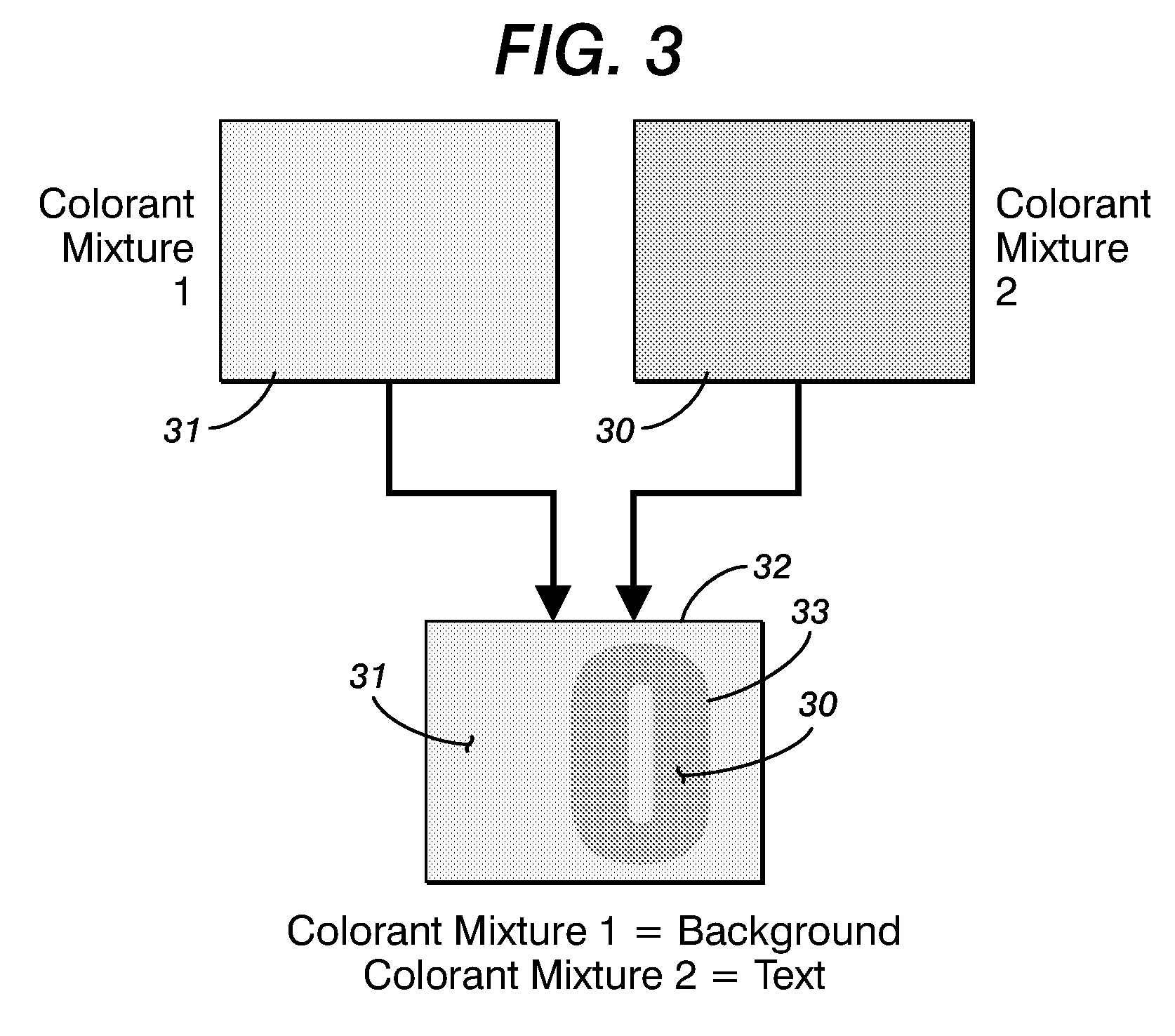[0003] It is desirable to have a way to provide detection of the counterfeiting, illegal alteration, and / or
copying of a document, most desirably in a manner that will provide
document security and which is also applicable for digitally generated documents. It is desirable that such a solution also have minimum
impact on
system overhead requirements as well as minimal storage requirements in a digital
processing and printing environment. Additionally, it is highly desirable that this solution be obtained without physical modification to the printing device and without the need for costly special materials and media.
[0007] Disclosed in embodiments herein is a fluorescent mark indicator comprising a substrate containing optical brightening agents, a first spatial color pattern and a second spatial color pattern printed as an image upon the substrate. The first spatial color pattern is further comprised of a first colorant mixture and a second colorant mixture arranged in a first repeating spatial pattern, the
resultant first spatial color pattern having a property of high suppression of substrate fluorescence. The second spatial color pattern is printed as an image upon the substrate in substantially close spatial proximity to the printed first spatial color pattern. The second spatial color pattern is further comprised of a third colorant mixture and a forth colorant mixture in a second repeating spatial pattern, the
resultant second spatial color pattern having a property of low suppression of substrate fluorescence, and a property of
low contrast against the first spatial color pattern. The arrangement is such that the resultant printed substrate image suitably exposed to an ultra-
violet light source, will yield a discernable pattern evident as a fluorescent mark.
[0008] Further disclosed in embodiments herein, is a fluorescent mark indicator comprising a substrate containing optical brightening agents, a first spatial color pattern and a second spatial color pattern printed as an image upon the substrate. The first spatial color pattern is further comprised of a first colorant mixture and a second colorant mixture arranged in a first repeating spatial pattern, the resultant first spatial color pattern having a property of high suppression of substrate fluorescence. The second spatial color pattern is printed as an image upon the substrate in substantially close spatial proximity to the printed first spatial color pattern. The second spatial color pattern is further comprised of a the first colorant mixture and a third colorant mixture in the same repeating spatial pattern, the resultant second spatial color pattern having a property of low suppression of substrate fluorescence, and a property of
low contrast against the first spatial color pattern. The arrangement is such that the resultant printed substrate image suitably exposed to an ultra-
violet light source, will yield a discernable pattern evident as a fluorescent mark.
[0009] Further disclosed in embodiments herein, is a
system for creating a fluorescence mark comprising a paper substrate containing optical brightening agents, and a digital
color printing system. The digital
color printing system further comprising at least one first spatial color pattern and at least one second spatial color pattern printed as an image upon the substrate. The first spatial color pattern further comprised of a first colorant mixture and a second colorant mixture in a first repeating spatial pattern, the resultant first spatial color pattern having a property of high suppression of substrate fluorescence. The at least one second spatial color pattern printed as an image upon the substrate in substantially close spatial proximity to the printed first spatial color pattern, the second spatial color pattern further comprised of a third colorant mixture and a forth colorant mixture in a second repeating spatial pattern, the resultant second spatial color pattern having a property of low suppression of substrate fluorescence and a property of low contrast against the first spatial color pattern. The result is that an image printed with the digital
color printing system on the paper substrate, the image comprising at least said first spatial color pattern and said second spatial color pattern arranged in close spatial proximity to each other, the
spatial image arrangement of the at least two spatial color patterns will reveal a fluorescence mark when the printed
color image is viewed under
ultraviolet light.
[0010] Further disclosed in embodiments herein is a fluorescent mark indicator comprising a substrate containing optical brightening agents, a first spatial color pattern and a second spatial color pattern printed as an image upon the substrate. The first spatial color pattern is further comprised of a first colorant mixture and at least a second colorant mixture arranged in a first repeating spatial pattern, the resultant first spatial color pattern having a level of suppression of substrate fluorescence. The second spatial color pattern is printed as an image upon the substrate in substantially close spatial proximity to the printed first spatial color pattern. The second spatial color pattern is further comprised of a third colorant mixture and at least a forth colorant mixture in a second repeating spatial pattern, the resultant second spatial color pattern having a second level of suppression of substrate fluorescence, and a property of low contrast against the first spatial color pattern under normal illumination. The arrangement is such that the resultant printed substrate image suitably exposed to an ultra-violet
light source, will yield a discernable pattern evident as a fluorescent mark, by exhibiting a discernible first and second level of suppression of substrate fluorescence.
 Login to View More
Login to View More  Login to View More
Login to View More 


